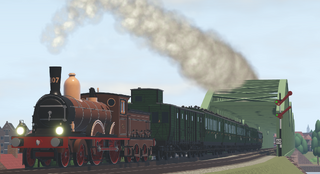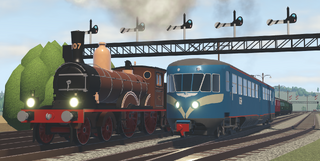 | |
| NRS 107 | |
|---|---|
| by Supersnel11 | |
| Price | 400 Robux |
| Gamepass | Preserved Four |
| Statistics | |
| Type | Passenger |
| Top Speed | 100 km/h |
| Weight | 83 tons |
| Capacity | 320 tons |
| Passenger Capacity | 2 first class 3 second class |
| Length | 16,4 meters |
The NRS 101-109 was a class of 9 Dutch 2'B (4-4-0) passenger locomotives. The class was built and designed by Sharp Stewart and Co. between 1889 and 1903 for the Nederlandsche Rhijnspoorweg-Maatschappij (NRS) and would later become a part of the NS 1600 class.
Variants
NRS 107 is only available in the NRS brown livery.
Historical details
The early days
This locomotive, along with 101-108, was ordered at Sharp Stewart & Co. in 1888 and would be delivered a year later. It was the very last locomotive the NRS would order before they would be disbanded in 1890. They were the first Dutch locomotives to have them, which granted them the nickname of "Rhijnbogen", after the Rhijn-railway where they were from the English word 'bogie'.
All nine of the first batch were tested on the London, Brighton & South Coast Railway prior to being shipped to the NRS.
NRS 101-109 were put on the most important trains of the NRS, in particular the D-trains (international, long distance trains for which a surcharge had to be paid) to Germany. Without any locomotive changes, these locomotives pulled the D-trains to Oberhausen. They were quite the spectacle there; the Prussian railways did not have any bogied locomotives yet.
The HSM years
The class of nine worked a little over the year at the NRS before it was disbanded. NRS 107 was among the four that were sold to the HSM. The rest would go to the Staatsspoorwegen briefly before they sold theirs to the HSM. Because the series was whole again, NRS 107 would be renumbered to HSM 353 (as a part of the series 350-358).
The locomotives were a great success and were partially responsible for the HSM no longer buying locomotives from the German Borsig and the series being expanded from nine members to 59.
The series got demoted to secondary jobs when the first of the HSM 421-460 (later the NS 1900) entered service. The 'Rhijnbogen' were pushed to secondary jobs, mainly the less important local trains.
A coal shortage during the the First World War forced the HSM to scrap a lot of services. Consequently, several of their locomotives, including 39 'Rhijnbogen', were stored away. This included HSM 353, which was stored in Zaandam together with 354 (ex-NRS 101) The Rhijnbogen were not returned to service until 1919, with the last remaining stored until 1920.
End of service
With the formation of NS in 1921, the Rhijnbogen were renumbered to the NS 1600 class. HSM 353 was renumbered to NS 1604. She was stationed in the old Staatsspoorwegen depot in Den Haag from 1924 to 1935, when the first of the class were withdrawn. 1604 was the last of the class to be withdrawn, all the way in 1940. It was not scrapped as it had been chosen to be put in the new railway museum.
Together with other rolling stock with the same destination, she was moved from the dilapidated shed at Boxtel to Roosendaal depot in 1943. And then the British bombed it. The locomotives that were damaged during this, including 1604, were stored in a large shed in Maastricht. Which the Germans blew up shortly before the Dutch liberation.

When the south of the Netherlands was liberated, the NS 1604 was brought to the locomotive scrapyard at Baarle-Nassau. The 1604 was treated like any other locomotive; their status as museum pieces was not known by the authorities. After that 1604 was stored in Almelo in 1947 and in Arnhem in 1948. It took until 1953 for the direction of NS to grant permission to restore the locomotives destined for the railway museum.
Number 1604 had the honour of being restored first, that very year. She was restored to her NRS appearance and even got her original tender back. She now rests on a raised platform right at the entrance of the museum.
Technical details
These locomotives were equipped with Westinghouse brakes (automatic and independent); a connection for steam heating on the back of the tender, a screw reverser, Gresham & Craven steam-powered sanders and a Kapteijn-speedometer, driven by one of the bogie wheels.
When the series 600 of the HSM (later NS 3200) entered service in 1895-1896, the tenders of the 601-605 & 609-612 were swapped with the tenders of these ex-NRS machines. The tenders of the 600s were of a new, broader design which had more capacity for both water and coal, which allowed the HSM to use these locomotives more effectively on long distance express trains.
Later, they were fitted with a second connection for steam heating, on the front of the locomotive. In the early 1900s, they also received a Knorr pre-heater with a heating surface of 9,2 m² and a pump with a capacity of 120 litres a minute.
Most of the class were equipped with an air bell and a tender cab by NS in the 1930s. NS also replaced the original speedometers with Stroudley-speedometers taken from other locomotives.
Trivia
- The preserved NRS 107 livery was added in version 0.5 alongside the Preserved Four gamepass.
- Prior to version 0.8.15, NRS 107 was a livery of the NS 1600.
Gallery
-
NRS 107 leaves the first section of the Voorlem rail bridge.
-
NRS 107 exits the yard of Voorlem, together with a DE-1.


